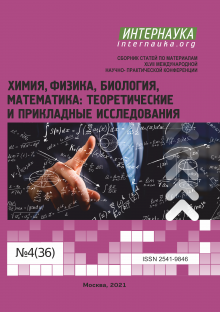TECHNOGENIC-MINERAL FORMATIONS OF THE KOMAROV DEPOSIT AS A SOURCE OF ANTHROPOGENIC IMPACT ON THE ENVIRONMENT

TECHNOGENIC-MINERAL FORMATIONS OF THE KOMAROV DEPOSIT AS A SOURCE OF ANTHROPOGENIC IMPACT ON THE ENVIRONMENT
Yermek Hairulla
Master student, Kostanay Regional University named after A. Baitursynov,
Kazakhstan, Kostanay
Tatyana Chekhova Tatyana
Candidate of Biological Sciences, Associate Professor, Kostanay Regional University named after A. Baitursynova,
Kazakhstan, Kostanay
ТЕХНОГЕННО-МИНЕРАЛЬНЫЕ ОБРАЗОВАНИЯ КОМАРОВСКОГО МЕСТОРОЖДЕНИЯ КАК ИСТОЧНИК АНТРОПОГЕННОГО ВОЗДЕЙСТВИЯ НА ОКРУЖАЮЩУЮ СРЕДУ
Хайрулла Ермек Ганиулы
магистрант, Костанайский региональный университет им. А.Байтурсынова,
Казахстан, г. Костанай
Чехова Татьяна Ивановна
канд. биол. наук, доц., Костанайский региональный университет им. А.Байтурсынова,
Казахстан, г. Костанай
ABSTRACT
The article covers the issue of technogenic-mineral formations of the Komarov gold deposit and their impact on the components of the environment. Measures to reduce the anthropogenic impact on the environment are described.
АННОТАЦИЯ
В статье освещаются вопрос техногенно-минеральных образований Комаровского золоторудного месторождения и их влияние на компоненты окружающей среды. Описаны мероприятия по снижению антропогенного воздействия на окружающую среду.
Keywords: technogenic-mineral formations, overburden rocks, mining enterprises.
Ключевые слова: техногенно-минеральные образования, вскрышные породы, горнодобывающие предприятия.
The current scale of mining production is characterized by the intensive use of natural resources, the increase in waste and the deterioration of the quality of the environment. In this regard, more and more attention is paid to the issue of economically sound and environmentally safe operation of the mining enterprise. The specific impact of a particular mining enterprise on the environment is determined by the geological and geochemical features of the deposits and the equipment and technology used for its development. [1]
Komarov Mining Enterprise LLP is one of the large enterprises of the Kostanay region. The contract territory of the Komarovsky field is administratively located in the Zhitikara district in the southwestern part of the Kostanay region of the Republic of Kazakhstan. The extraction of gold-bearing ores is carried out by an open method. The method of mining a quarry is excavated, dump formation is bulldozed.[2]
A study of the actual emissions to the environment from the enterprise "KGP" LLP for a five-year period was conducted. [3] The results are presented in Figure 1.
Figure 1-Actual emissions of KGP LLP into the environment for 2016-2020.

Figure 1. Production and consumption waste, (thousand tons / year)
The analysis of the obtained data showed that in the course of mining operations at the Komarovsky gold deposit, the volume of industrial waste generation and disposal has been increasing annually since 2016. So, in 2020, 36261.9 thousand tons were formed, which is 10 times more than in 2016 (3528,178 thousand tons).
The lion's share of the generated production and consumption waste is occupied by overburden, an integral by-product of mineral extraction.
Air pollution also occurs during mining operations. Dredging and loading operations with their subsequent transportation to dumps and overburden dumps-all this causes the release of inorganic dust containing silicon dioxide in%: 70-20.
To prevent potential threats to the ecosystem, as well as to reduce the anthropogenic impact on the environment, it is necessary to carry out the following measures:
1) To protect the atmosphere from pollution by harmful substances, air protection measures should be carried out to reduce the concentrations of pollutants in the air to the maximum permissible concentrations. For road transport operations in the warm season, use hydro-irrigation of roads for dust suppression [4];
2) To prevent environmental pollution during the disposal of waste, first of all, reuse the maximum possible amount of waste, use overburden as a building material for filling quarry roads, etc. [5]
Another effective method for reducing waste disposal is the use of internal dumps. [4,5] However, a certain amount of waste space is required for the placement of rock in the internal dump. Therefore, at this stage of career development, this is not yet applicable. But in the future, after creating the required capacity of the developed space, I believe that the transition to the internal placement of dumps is feasible.
The proposed measures will reduce the disposal of overburden waste, as well as reduce the anthropogenic impact on the environment.
Список литературы:
- Базарова С. Воздействие горнодобывающих предприятий на экосистему региона и оценка эффективности их экологической деятельности// Региональная экономика и управление: электронный научный журнал. ISSN 1999-2645. — №2 (10). Номер статьи: 1008. Дата публикации: 2007-06-25 . Режим доступа: https://eee-region.ru/article/1008/;
- https://www.polymetalinternational.com;
- Отчеты предприятия по фактическим эмиссиям и иные данные находящихся в ведении уполномоченного органа в области охраны окружающей среды;
- Инструкция по охране природной среды при строительстве, ремонте и содержании автомобильных дорог. ВСН 8-89/Минавтодор РСФСР. - М.: ГУП ЦПП, 1999;
- Кауппила П. и др. Наилучшие экологические практики в горнодобывающей промышленности. ISBN 978-952-11-4187-4. 2011.
